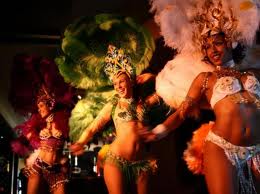Samba
Samba is a lively, rhythmical dance of Brazilian origin in 2/4 time. However, there are three steps to every bar (slow, quick-quick), making the samba feel something like a 3/4 timed dance.
There are two major streams of Samba that differ considerably: the modern ballroom samba, and the traditional Samba of Brazil. Traditional Brazilian Samba includes the partner dance, Samba de Gafieira, as well as Samba no pé, which is danced solo at carnival.
Origins
The ballroom Samba has its origins in Brazil at the beginning of the 20th century. Many steps can be traced back to the Maxixe danced in 1910s. A book published in France in 1928 already described how to perform the Samba.
Style
As a ballroom dance, the Samba is a partner dance. Ballroom Samba, like other ballroom dances, is somewhat disconnected from the origins and evolution of the music and dance that gives it its name. It is a form adapted for its suitability as a partner dance. The dance movements, which do not change depending on the style of Samba music being played, borrows some movements from Afro-Brazilian traditional dances such those used in candomblé rituals and the chamadas of capoeira angola.
The ballroom Samba is danced to music in 2/4 or 4/4 time. The basic movements are counted either 1-2 or 1-a-2, and are danced with a slight downward bouncing or dropping action. This action is created through the bending and straightening of the knees, with bending occurring on the beats of 1 and 2, and the straightening occurring on the “a”. Samba is notable for its constantly changing rhythms, with cross-rhythms being a common feature.
Music Examples:
1. Taka Taka Tak by Legendarios Do Brazil
2. Copacabana by Barry Manilow
3. Bamboleo by Gipsy Kings

